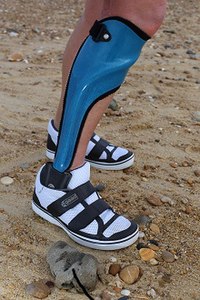
Photo from wikipedia
CONTEXT The authors hypothesized that in people with hip-related groin pain, less static ankle dorsiflexion could lead to compensatory hip adduction and contralateral pelvic drop during step-down. Ankle dorsiflexion may… Click to show full abstract
CONTEXT The authors hypothesized that in people with hip-related groin pain, less static ankle dorsiflexion could lead to compensatory hip adduction and contralateral pelvic drop during step-down. Ankle dorsiflexion may be a modifiable factor to improve ability in those with hip-related groin pain to decrease hip/pelvic motion during functional tasks and improve function. OBJECTIVE To determine whether smaller static ankle dorsiflexion angles were associated with altered ankle, hip, and pelvis kinematics during step-down in people with hip-related groin pain. DESIGN Cross-sectional Setting: Academic medical center. PATIENTS A total of 30 people with hip-related groin pain (12 males and 18 females; 28.7 [5.3] y) participated. INTERVENTION None. MAIN OUTCOME MEASURES Weight-bearing static ankle dorsiflexion with knee flexed and knee extended were measured via digital inclinometer. Pelvis, hip, and ankle kinematics during forward step-down were measured via 3D motion capture. Static ankle dorsiflexion and kinematics were compared with bivariate correlations. RESULTS Smaller static ankle dorsiflexion angles were associated with smaller ankle dorsiflexion angles during the step-down for both the knee flexed and knee extended static measures. Among the total sample, smaller static ankle dorsiflexion angle with knee flexed was associated with greater anterior pelvic tilt and greater contralateral pelvic drop during the step-down. Among only those who did not require a lowered step for safety, smaller static ankle dorsiflexion angles with knee flexed and knee extended were associated with greater anterior pelvic tilt, greater contralateral pelvic drop, and greater hip flexion. CONCLUSIONS Among those with hip-related groin pain, smaller static ankle dorsiflexion angles are associated with less ankle dorsiflexion motion and altered pelvis and hip kinematics during a step-down. Future research is needed to assess the effect of treating restricted ankle dorsiflexion on quality of motion and symptoms in patients with hip-related groin pain.
Journal Title: Journal of sport rehabilitation
Year Published: 2020
Link to full text (if available)
Share on Social Media: Sign Up to like & get
recommendations!